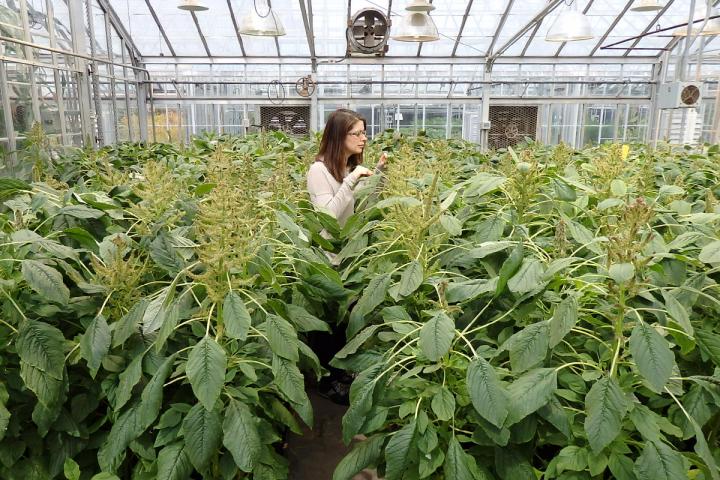
Credit: Photo courtesy Patrick Tranel
CHAMPAIGN, Ill. — After exposing more than 70 million grain amaranth seeds to a soil-based herbicide, researchers were not able to find a single herbicide-resistant mutant. Though preliminary, the findings suggest that the mutation rate in amaranth is very low, and that low-level herbicide application contributes little – if anything – to the onset of new mutations conferring resistance, researchers say.
The study is reported in the journal Weed Science.
Any major stress that does not kill a plant can contribute to genetic mutations in its seeds and pollen, said University of Illinois crop sciences professor Patrick Tranel, who led the new research. Even the ultraviolet light in sunlight can stress a plant and increase the likelihood of mutations in its offspring, he said. Such mutations increase genetic diversity, which can be useful to a species’ survival.
“Resistance to herbicides comes from genetic variation in a population,” Tranel said. “If an individual weed has the right mutation that allows it to survive a particular herbicide, that individual will survive and pass the trait to its progeny.”
The relative contribution of new mutations to the problem of herbicide resistance is poorly understood, Tranel said. He and his colleagues hoped to determine the baseline mutation rate for a plant of the genus Amaranthus, a group that includes waterhemp, Palmer amaranth and other problematic agricultural weeds. They also wanted to test whether herbicide applications that failed to kill the plant increased that baseline rate.
The researchers started with a single seed of Amaranthus hypochondriacus, which is closely related to several agricultural weeds but is not known to harbor herbicide-resistance genes. Using a greenhouse to isolate their experiments from potential contamination from other Amaranthus species, the team cultivated this one plant, collected its seeds and began the long process of growing generations of related plants and harvesting the seeds.
“A good plant would produce about 100,000 seeds,” Tranel said. “From this one plant, we eventually got more than 70 million seeds.”
Despite the laboratory’s isolation and the vigilance of the scientists, a few other Amaranthus weed seeds made their way into the experiment.
“These seeds are tiny and cling to things. You can have a seed stuck to your skin and not know it,” Tranel said. “One of the students found a weed seed in his eyebrow after he left the greenhouse.”
Luckily for the scientists, the seeds of the weedy Amaranthus species are black, while their test plants produced only light-colored seeds.
To screen the seeds for herbicide resistance, the researchers spread them over the surface of soil treated with a type of herbicide known as an ALS inhibitor, then waited to see whether any of the seedlings survived. Very few of the test plants overcame the herbicide treatment. Rigorous testing revealed that those rare plants that did survive were the offspring of seeds of weedy amaranth species that already carried the resistance genes.
The experiments verified that the scientists’ approach worked well for screening vast numbers of seeds. It also established that the team would have to test many more than 70 million seeds to determine the baseline mutation rate in A. hypochondriacus – and to figure out if low-level herbicide treatment increases that rate, Tranel said.
Knowing this is essential to developing models that can accurately predict how plants will behave in a field, he said.
“Herbicide resistance is an evolutionary process, and evolutionary processes are mathematical,” Tranel said. “If you know more precisely how plants will behave under different environmental conditions, you can develop equations that will predict how fast resistance will evolve.”
If, as the study suggests, the mutation rate is much lower than expected, it doesn’t mean that herbicide resistance will not occur, he said. “It may be that resistance happens a bit more slowly than previously thought,” he said. “But it will still occur.”
###
The U.S. Department of Agriculture National Institute of Food and Agriculture provided partial funding for this research. No conflicts of interest have been declared.
Editor’s notes:
To reach Patrick Tranel, call 217-333-1531; email [email protected].
The paper “Empirical investigation of mutation rate for herbicide resistance” is available online and from the U. of I. News Bureau.
Media Contact
Diana Yates
[email protected]
Original Source
https:/
Related Journal Article
http://dx.




